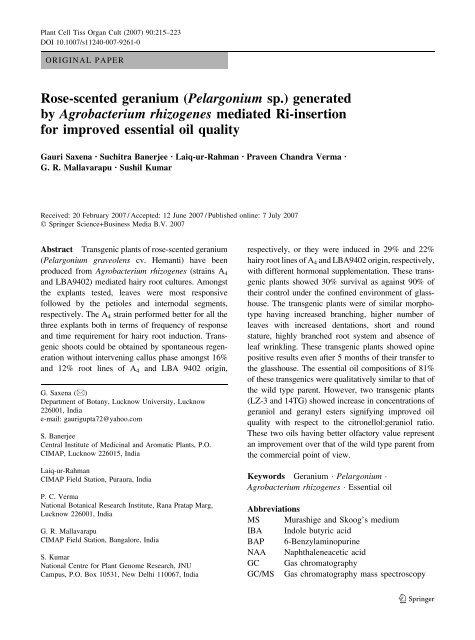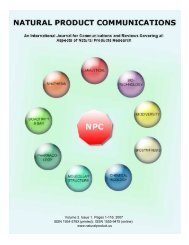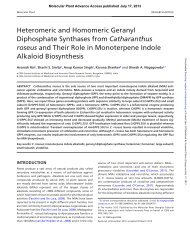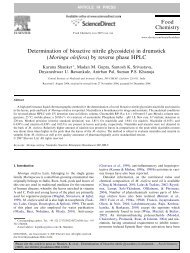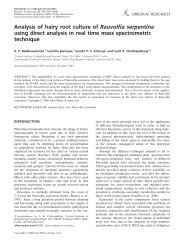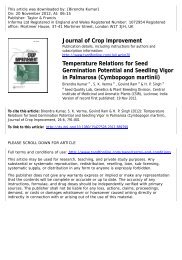Rose-scented geranium - CIMAP Staff - Central Institute of Medicinal ...
Rose-scented geranium - CIMAP Staff - Central Institute of Medicinal ...
Rose-scented geranium - CIMAP Staff - Central Institute of Medicinal ...
Create successful ePaper yourself
Turn your PDF publications into a flip-book with our unique Google optimized e-Paper software.
Plant Cell Tiss Organ Cult (2007) 90:215–223DOI 10.1007/s11240-007-9261-0ORIGINAL PAPER<strong>Rose</strong>-<strong>scented</strong> <strong>geranium</strong> (Pelargonium sp.) generatedby Agrobacterium rhizogenes mediated Ri-insertionfor improved essential oil qualityGauri Saxena Æ Suchitra Banerjee Æ Laiq-ur-Rahman Æ Praveen Chandra Verma ÆG. R. Mallavarapu Æ Sushil KumarReceived: 20 February 2007 / Accepted: 12 June 2007 / Published online: 7 July 2007Ó Springer Science+Business Media B.V. 2007Abstract Transgenic plants <strong>of</strong> rose-<strong>scented</strong> <strong>geranium</strong>(Pelargonium graveolens cv. Hemanti) have beenproduced from Agrobacterium rhizogenes (strains A 4and LBA9402) mediated hairy root cultures. Amongstthe explants tested, leaves were most responsivefollowed by the petioles and internodal segments,respectively. The A 4 strain performed better for all thethree explants both in terms <strong>of</strong> frequency <strong>of</strong> responseand time requirement for hairy root induction. Transgenicshoots could be obtained by spontaneous regenerationwithout intervening callus phase amongst 16%and 12% root lines <strong>of</strong> A 4 and LBA 9402 origin,G. Saxena (&)Department <strong>of</strong> Botany, Lucknow University, Lucknow226001, Indiae-mail: gaurigupta72@yahoo.comS. Banerjee<strong>Central</strong> <strong>Institute</strong> <strong>of</strong> <strong>Medicinal</strong> and Aromatic Plants, P.O.<strong>CIMAP</strong>, Lucknow 226015, IndiaLaiq-ur-Rahman<strong>CIMAP</strong> Field Station, Puraura, IndiaP. C. VermaNational Botanical Research <strong>Institute</strong>, Rana Pratap Marg,Lucknow 226001, IndiaG. R. Mallavarapu<strong>CIMAP</strong> Field Station, Bangalore, IndiaS. KumarNational Centre for Plant Genome Research, JNUCampus, P.O. Box 10531, New Delhi 110067, Indiarespectively, or they were induced in 29% and 22%hairy root lines <strong>of</strong> A 4 and LBA9402 origin, respectively,with different hormonal supplementation. These transgenicplants showed 30% survival as against 90% <strong>of</strong>their control under the confined environment <strong>of</strong> glasshouse.The transgenic plants were <strong>of</strong> similar morphotypehaving increased branching, higher number <strong>of</strong>leaves with increased dentations, short and roundstature, highly branched root system and absence <strong>of</strong>leaf wrinkling. These transgenic plants showed opinepositive results even after 5 months <strong>of</strong> their transfer tothe glasshouse. The essential oil compositions <strong>of</strong> 81%<strong>of</strong> these transgenics were qualitatively similar to that <strong>of</strong>the wild type parent. However, two transgenic plants(LZ-3 and 14TG) showed increase in concentrations <strong>of</strong>geraniol and geranyl esters signifying improved oilquality with respect to the citronellol:geraniol ratio.These two oils having better olfactory value representan improvement over that <strong>of</strong> the wild type parent fromthe commercial point <strong>of</strong> view.Keywords Geranium Pelargonium Agrobacterium rhizogenes Essential oilAbbreviationsMS Murashige and Skoog’s mediumIBA Indole butyric acidBAP 6-BenzylaminopurineNAA Naphthaleneacetic acidGC Gas chromatographyGC/MS Gas chromatography mass spectroscopy123
218 Plant Cell Tiss Organ Cult (2007) 90:215–223RAPD analysis was done according to the protocol byShoyama et al. (1997). Two transgenic plants (2TGand 14TG) were analyzed in replicates in order todemonstrate genetic uniformity within the clone.Results and discussionA transformation frequency from leaf explants wasthe highest, followed by the petioles and internodalsegments (Table 2). However, young leaf petioles didnot produce hairy roots in any <strong>of</strong> the Pelargoniumspecies tested (Pellegrineschi and Mariani 1996).Although transformation frequencies was high withboth the bacterial strains used in this study, as hasalso been reported in lemon-<strong>scented</strong> <strong>geranium</strong> (Pellegrineschiet al. 1994). Amongst the two bacterialstrains used, A 4 proved to be effective than LBA9402, both in terms <strong>of</strong> frequency <strong>of</strong> response and timerequirement for hairy-root induction (Table 2). Similarobservations had also been reported earlier fordiverse plant species (Porter 1991; Rodrigues et al.1991; Banerjee et al. 1994; Giri 1997; Zehra 1998).In view <strong>of</strong> the fact that each transformation eventis distinct from the other due to different integrationsites and copy numbers <strong>of</strong> Ri T-DNA (Tepfer 1984),90 independent hairy-root lines <strong>of</strong> A 4 origin and 60 <strong>of</strong>LBA 9402 origin were selected for regenerationstudies (Fig. 1A). Amongst these, 14 regenerants byA 4 and seven root lines by LBA 9402 origin showedspontaneous regeneration without the interveningcallus phase within 8–10 weeks <strong>of</strong> subculturing inhormone-free liquid and semi-solid MS medium(Fig. 1B and C; Table 1). Spontaneous regeneration<strong>of</strong> plants from hairy root cultures has already beenreported in Pelargonium (Pellegrineschi et al. 1994;Pellegrineschi and Mariani 1996; Banerjee et al.1997; Perez-Morphe-Balch and Ochoa-Alejo 1987).Direct organogenesis was observed in 26 and 13 <strong>of</strong>the hairy root lines <strong>of</strong> A 4 and LBA 9402 origin,respectively (Table 3), within 6–8 weeks <strong>of</strong> culturewith different hormonal combinations.Only two <strong>of</strong> the five regeneration media testedwith varying concentrations <strong>of</strong> NAA and BAPresponded both in their semi-solid and liquid state.A maximum <strong>of</strong> 6–8 shoots per root explant wasproduced after 7 weeks <strong>of</strong> culture containing 0.5 mg/lBAP and 0.1 mg/l NAA (Table 1). These concentrationswere lower than those as reported in regalPelargonium (Pelargonium · domesticum Dubonnet)(Boase et al. 1998). Various combinations <strong>of</strong> differenthormones including NAA, BAP, zeatin as well assupplementary vitamin source and PVP-10 have beenused for inducing direct and indirect regeneration <strong>of</strong>transgenic shoots through transformation with A.tumefaciens in leaf discs <strong>of</strong> Zonal (Pelargonium· hortorum) and <strong>scented</strong> (P. capitatum)<strong>geranium</strong> (Hassanein et al. 2005).It is pertinent to mention here, that in addition todifferent hormonal combinations, reduction in theconcentrations <strong>of</strong> sucrose as well as that <strong>of</strong> othernutrients to half appears to be an essential prerequisite<strong>of</strong> the present study in order to optimize the shootregeneration efficiency from hairy root cultureswhich has not been considered earlier (Boase et al.1998).All the transgenic plantlets <strong>of</strong> the present study,irrespective <strong>of</strong> their spontaneous or hormone-mediatedorigin, exhibited spontaneous rhizogenesis upontransfer to hormone-free half strength MS mediumwithin 2 weeks <strong>of</strong> transfer (Fig. 1E).A total <strong>of</strong> 11 transgenic plants out <strong>of</strong> the total36 tested were successfully transferred to theglasshouse. The leaves <strong>of</strong> all transformed plantswere darker in colour, more dentated and leafwrinkling was absent in all <strong>of</strong> them as has also beenreported earlier (Pellegrineschi et al. 1994).The transformants also had highly branched rootsystems, shorter internodes, increased number <strong>of</strong>leaves and branches and short and round stature <strong>of</strong>Table 2 Susceptibility <strong>of</strong>different explants <strong>of</strong>Pelargonium graveolens cv.Hemanti to A 4 and LBA9402 strains <strong>of</strong>Agrobacterium rhizogenesBacterial strainsTransformation frequencyInternode Petiole LeafA 4 50 ± 3.2 71.3 ± 3.3 100 ± 0.0LBA 9402 20 ± 1.9 50 ± 2.6 82 ± 4.1123
Plant Cell Tiss Organ Cult (2007) 90:215–223 219Fig. 1 Generation <strong>of</strong>Agrobacterium rhizogenesmediated transgenic plantsin Pelargonium graveolensIndian cultivar Hemanti;A; Hairy root culturemaintained for 2 weeks inhalf strength, hormone freeliquid MS medium; B–C:regeneration <strong>of</strong> plantletsfrom hairy root culture insemi-solid and liquidculture media, respectively;D–E: in vitro raised rootedcontrol and transformedplants; F: Control (left) andtransformed (right) plantsafter 10 weeks <strong>of</strong> growth inpots exhibiting increasedbranching and highernumber <strong>of</strong> leaves in thelatter (· 0.10); G–H: flower<strong>of</strong> control and transformed(LZ-3) plant exhibitingaltered morphology (· 3.5)Table 3 Frequency <strong>of</strong>regeneration from hairyroots <strong>of</strong> Pelargoniumgraveolens cv. Hemantiinduced with A 4 and LBA9402 strains <strong>of</strong>Agrobacterium rhizogenesGenetic resourceBacterial strain used for hairy rootinductionA 4 LBA 9402Total number <strong>of</strong> root lines 90 60Total number <strong>of</strong> root lines that exhibited regeneration 40 20Number <strong>of</strong> lines showing spontaneous regeneration 14 07Number <strong>of</strong> lines where regeneration was induced 26 13the plants as compared to that <strong>of</strong> the control(Fig 1D–F). The number <strong>of</strong> branches and roots/plants differ significantly as indicated by T-test(Fig. 2). Similar variations had also been reportedin the case <strong>of</strong> other Pelargonium species (Pellegrineschiet al. 1994; Pellegrineschi and Mariani1996). All the transgenics showed opine positiveresults even after 5 months <strong>of</strong> transfer to the pot.123
220 Plant Cell Tiss Organ Cult (2007) 90:215–223Fig. 2 Comparativeaccount <strong>of</strong> variousmorphological characters <strong>of</strong>transgenic and controlplants <strong>of</strong> Pelargoniumgraveolens cv. Hemanti8070605040302010Control Plants TransgenicPlants0Plant height (cm)No. <strong>of</strong> branchesNodes/branchLeaves/branchMorphologicalcharactesrRoots/plantRoot length (cm)One <strong>of</strong> the 11 transgenic plants, LZ-3, producedflowers in 3 months with two inflorescences, eachbearing four flowers could be seen during the entirecultivation period and the flower size was smallerwith reduced petals and abnormality in their shape(Fig. 1G and H). The small flower size in thetransgenic plant in comparison to control was alsoreported in tobacco (Tepfer 1984). A hundred percentpollen sterility could be recorded through acetocarminestaining technique. The cuttings were usedfor maintaining and further multiplication <strong>of</strong> transgenicplants for three successive years.All the 11 transgenic plants along with theircontrol were subjected to quantitative and qualitativeanalysis <strong>of</strong> their essential oils after 5 months <strong>of</strong>transfer to the pots. It was observed that all the plantsshowed stable behaviour in this duration. The oilcontents <strong>of</strong> all the transgenics were comparativelylower than the wild type (Table 4) in contrast to anearlier report (Pellegrineschi et al. 1994). Taking intoconsideration the number <strong>of</strong> leaves and branches, anoverall increase in the oil yield can be predicted fromthe transgenics since higher herb yield normally has astronger correlation with the oil yield per plant(Saxena et al. 2000). The analysis showed that theoils <strong>of</strong> nine transgenic plants (A6, 2TG, 5TG, 6TG,10TG, 12TG, 13TG, 15TG and 20TG) had compositionsimilar to that <strong>of</strong> the control Hemanti type(Table 4) which represents Chinese <strong>geranium</strong> oil inhaving higher amounts <strong>of</strong> citronellol and loweramounts <strong>of</strong> geraniol (Saxena et al. 2000). Theconcentrations <strong>of</strong> citronellol and geraniol as well astheir esters were found to be at par in thesetransgenics with those <strong>of</strong> the wild type oil. Amongthese nine transgenics, the oil <strong>of</strong> A6 was unique inhaving very low concentration <strong>of</strong> 10-epi-c-eudesmol(0.2%) which signifies better odour value (Teisseire1987). As compared to the oils <strong>of</strong> the other eighttransgenics and the control, the oil <strong>of</strong> 6TG was foundto contain lower concentration <strong>of</strong> isomenthone.Unaltered oil pr<strong>of</strong>iles <strong>of</strong> these transgenics mightrepresent the fact that the insertion sites <strong>of</strong> Ri TDNAin these plants do not interfere with the secondarymetabolites biosynthetic pathway as is mostly notedin majority <strong>of</strong> medicinal plants (Jung and Tepfer1987; Banerjee et al. 1998; Zehra et al. 1999).The RAPD analysis <strong>of</strong> these transgenics alsorevealed similarity at genetic level with that <strong>of</strong> thewild type in terms <strong>of</strong> most <strong>of</strong> the primers used.However, the primer OPT 1 revealed distinct differencesbetween the wild type and A6 in terms <strong>of</strong> thepolymorphic bands (Fig. 3) which might account forthe distinctiveness <strong>of</strong> A6 in terms <strong>of</strong> its unique oilpr<strong>of</strong>ile in having very low concentrations <strong>of</strong> 10-epi-ceudesmol.On the other hand, the difference inpolymorphic bands between the 15TG and controlwith regard to the same primer could not be corelatedwith any biochemical or morphologicalparameters in consideration, however changes inother physiological characters cannot be ruled out.Besides the above nine transgenics, the transgenicsLZ-3 and 14TG were found to differ in their oil123
Plant Cell Tiss Organ Cult (2007) 90:215–223 221Table 4 Oil content and percent concentration (±SD) <strong>of</strong> the terpenoid constituents in essential oils <strong>of</strong> transgenic plants and the wild type Pelargonium graveolens cv. HemantiCompound Control A-6 2TG 5TG 6TG 10TG 12TG I3TG 15TG 2OTG LZ-3 14TGOil content (%) 0.15 ± 0.01 0.11 ± 0.01 0.10 ± 0.06 0.06 ± 0.001 0.10 ± 0.01 0.09 ± 0.005 0.11 ± 0.005 0.05 ± 0.001 0.10 ± 0.04 0.10 ± 0.017 0.11 ± 0.010 0.11 ± 0.010Linalool 0.50 ± 0.04 1.00 ± 0.02 0.50 ± 0.02 0.30 ± 0.004 0.60 ± 0.008 0.50 ± 0.01 0.60 ± 0.016 0.40 ± 0.020 0.30 ± 0.005 0.90 ± 0.01 1.60 ± 0.04 0.90 ± 0.010<strong>Rose</strong> oxides (cis + trans) 2.50 ± 0.09 2.60 ± 0.14 1.60 ± 0.06 1.90 ± 0.07 0.70 ± 0.015 1.60 ± 0.09 1.80 ± 0.07 2.60 ± 0.16 2.40 ± 0.07 2.30 ± 0.02 1.60 ± 0.04 trIsomenthone 9.60 ± 0.40 10.9 ± 0.13 8.20 ± 0.11 9.50 ± 0.68 4.0 ± 0.28 8.00 ± 0.31 9.30 ± 0.37 9.40 ± 0.51 10.3 ± 0.49 9.50 ± 0.36 7.90 ± 0.33 1.80 ± 0.12Citronellol 47.0 ± 0.65 46.1 ± 0.45 45.6 ± 0.27 47.0 ± 0.62 54.4 ± 0.69 48.3 ± 0.78 52.4 ± 0.32 46.3 ± 0.66 46.9 ± 0.74 52.7 ± 0.55 35.7 ± 0.30 33.3 ± 0.88Geraniol 1.10 ± 0.11 0.70 ± 0.004 1.20 ± 0.06 0.50 ± 0.08 1.90 ± 0.09 0.80 ± 0.14 1.40 ± 0.06 0.40 ± 0.12 0.50 ± 0.08 2.00 ± 0.10 9.60 ± 0.40 7.90 ± 0.746- Caryophyllene 2.00 ± 0.09 2.10 ± 0.09 2.30 ± 0.12 2.50 ± 0.21 2.20 ± 0.05 2.10 ± 0.06 1.70 ± 0.03 2.30 ± 0.16 2.40 ± 0.10 1.60 ± 0.08 1.30 ± 0.06 2.00 ± 0.05Guaia-6,9- diene 2.70 ± 0.12 2.20 ± 0.09 1.40 ± 0.11 1.80 ± 0.06 1.40 ± 0.07 2.50 ± 0.10 2.00 ± 0.01 2.30 ± 0.08 1.80 ± 0.06 1.70 ± 0.54 0.30 ± 0.02 0.30 ± 0.01610-epi-Y-Eudesmol 3.80 ± 0.15 0.20 ± 0.01 4.40 ± 0.14 3.00 ± 0.21 5.00 ± 0.07 4.20 ± 0.05 4.20 ± 0.09 4.20 ± 0.08 3.00 ± 0.12 3.00 ± 0.14 6.60 ± 0.15 10.3 ± 0.27Citronellyl esters 20.4 ± 0.43 23.8 ± 0.49 23.2 ± 0.81 22.8 ± 0.72 19.7 ± 0.41 19.6 ± 0.96 17.0 ± 0.69 21.6 ± 0.62 22.7 ± 0.78 17.5 ± 1.16 12.9 ± 0.65 14.9 ± 0.88Geranyl esters 2.20 ± 0.09 1.50 ± 0.06 1.90 ± 0.04 1.50 ± 0.03 2.60 ± 0.09 1.80 ± 0.12 2.30 ± 0.12 1.10 ± 0.05 1.80 ± 0.03 2.00 ± 0.16 9.00 ± 0.19 14.8 ± 0.73tr, traceFig. 3 PCR pr<strong>of</strong>iles <strong>of</strong> DNA isolated from 11 transgenic plantsand their parent Pelargonium graveolens cv. Hemanti amplifiedwith primer OPT1 5 0 GGGCCACTCA3 0 and resolved on0.8% agarose gel. Samples in gel lanes (from right to left) areas follows: Lane 1: marker k DNA digested with HindIII ; Lane2: wild type Pelargonium graveolens cv. Hemanti; Lanes 3,4and 5: 2TG (in replicates); Lane 6: 5TG; Lane 7: 6TG; Lane 8:LZ-3; Lanes 9 and 12: 14TG (in replicate); Lane 10: 10TG;Lane 11: 12TG; Lane 12: 14TG; Lane 13: 13TG; Lane 14:15TG; Lane 15: 20TG; Lane 16: A-6pr<strong>of</strong>iles from that <strong>of</strong> the control oil (Table 4). Thesetwo oils had comparatively lower concentration <strong>of</strong>citronellol (33.3% and 35.7%) and higher concentration<strong>of</strong> geraniol (6.6% and 10.3%) than the control oilwhere citronellol was 47% and geraniol was 2.1%.Since the citronellol:geraniol ratio in <strong>geranium</strong> oilsdetermines their odour value (Lawrence 1984) thesetwo oils represent better quality oils resemblingBipuli type (Rao et al. 1999). The oils <strong>of</strong> these twotransgenic plants also possess relatively higheramounts <strong>of</strong> linalool, geranyl esters and 10-epi-ceudesmolas compared to that <strong>of</strong> the control. On theother hand, the concentrations <strong>of</strong> 6, 9-guaiadiene andthe esters <strong>of</strong> citronellol were found to be low in thesetwo oils as compared to the oil <strong>of</strong> the control. Further,the concentrations <strong>of</strong> isomenthone and rose oxideswere quite low (1.8% and trace, respectively) in one<strong>of</strong> these two oils (14TG) as compared to the oil <strong>of</strong>control (9.6% and 2.5%, respectively). At the geneticlevel these two transgenics resembled each other withregard to OPT 1 primer while distinct differencescould be noted between them from the others alongwith the wild type control with regards to sameprimer (Fig. 3) which further substantiates theirtotally altered oil pr<strong>of</strong>ile in terms <strong>of</strong> the majorterpenoid constituents. On the basis <strong>of</strong> overallanalysis, it can be stated that since the increase ingeraniol and geranyl esters concentration signifiesimproved olfactory value (Rao et al. 1999), the oils <strong>of</strong>these two transgenics definitely represent an improvementover the control from the commercial point <strong>of</strong>123
222 Plant Cell Tiss Organ Cult (2007) 90:215–223view. Reduction in citronellol concentration andincrease in geraniol concentration had earlier beennoted in three transgenic plants <strong>of</strong> lemon-<strong>geranium</strong> <strong>of</strong>hairy root origin (Pellegrineschi et al. 1994).The present study once again highlights thesuccess <strong>of</strong> hairy root transformation strategy for thecreation <strong>of</strong> new fragrances through the easiest andquickest method <strong>of</strong> establishment <strong>of</strong> transgenic plantsfrom hairy root cultures.Acknowledgements The authors are thankful to theDepartment <strong>of</strong> Biotechnology, Government <strong>of</strong> India for thefinancial support and the Regional SophisticationInstrumentation Facility, CDRI, Lucknow for GC-MS <strong>of</strong> theoils. Thanks are also due to S. Sharma and S.A. Hasan for theirhelp in manuscript preparation and A.P. Dhiman forphotography.ReferencesAdams RP (1995) Identification <strong>of</strong> essential oils by gas chromatographymass spectroscopy. Allured Publication Corporation,Carol Stream II, USABanerjee S, Naqvi AA, Mandal S, Ahuja PS (1994) Transformation<strong>of</strong> Withania somnifera (L) Dunal by Agrobacteriumrhizogenes: infectivity and phytochemical studies.Phytother Res 8:452–455Banerjee S, Rahman L, Uniyal GC, Ahuja PS (1998) Enhancedproduction <strong>of</strong> valepotriates by Agrobacterium rhizogenesinduced hairy root cultures <strong>of</strong> Valeriana wallichii DC.Plant Sci 131:203–208Banerjee S, Zehra M, Gupta MM, Kumar S (1997) Agrobacteriumrhizogenes mediated transformation <strong>of</strong> Artemisiaannua: prodcution <strong>of</strong> transgenic plants. Planta Med63:467–469Boase MR, Bradley JM, Borst NK (1998) An improved methodfor transformation <strong>of</strong> regal Pelargonium (Pelargoniuin· domesticum Dubonnet) by Agrobacteriurntumefaciens. Plant Sci 139:59–69Boase MR, Deroles SC, Winefield CS, Butcher SM, Borst NK,Butler RC (1996) Genetic transformation <strong>of</strong> Regal Pelargonium(Pelargonium · domesticum Dubormet) byAgrobacterium tumefaciens. Plant Sci 121:47–61Finnegan J, Elroy DMC (1994) Transgene inactivation: plantsfight back. Biotechnol 12:883–888Giri A, Banerjee S, Ahuja PS, Giri CC (1997) Production <strong>of</strong>hariy roots in Aconitum heterophyllum wall using Agrobacteriumrhizogenes. In vitro Cell Dev Biol (Plant)33:280–284Hassanein A, Chevreau E, Dorion N (2005) Highly efficienttransformation <strong>of</strong> zonal (Pelargonium · hortorum) and<strong>scented</strong> (P. capitatum) <strong>geranium</strong>s via Agrobacteriumtumefaciens using leaf discs. Plant Sci 169: 532–541Hooykass PJJ, Klapwijk PM, Nuti PM, Shilperoot RA, RorschA (1977) Transfer <strong>of</strong> the Agrobacterium turnefaciens Tiplasmid to avirulent Agrobacteria and rhizobium explanta.J Genet Microbiol 98:477–484Jenmings W, Shibamoto J (1980) Qualitative analysis <strong>of</strong> flavorand fragrance volatiles by glass capillary gas chromatography.Academic Press, New York IXJung G, Tepfer D (1987) Use <strong>of</strong> genetic transformation by theRi T-DNA <strong>of</strong> Agrobacteriuin rhizogenes to stimulatebiomass and tropane alkaloid production in Atropa belladonnaand Calystegia cepium roots grown in vitro. PlantSci 50:145–151Khanuja SPS, Kalra A, Singh AK (2005) Gains from Entrepreneurship.In: Ram N (ed) The Hindu–Survey <strong>of</strong> IndianAgriculture, National Press, Chennai, India pp 191–194Khanuja SPS, Shasany AK, Dhawan S, Kumar S (1998) Arapid procedure for isolating somaclones <strong>of</strong> alteredgenotypes in Mentha arvensis. J Med Arom Plant Sci20:359–361KrishnaRaj S, Bi YM, Saxena PK (1997) Somatic embryogenesisand Agrobacterium mediated transformation systemfor <strong>scented</strong> <strong>geranium</strong> (Pelargonium sp. ‘Frensham’).Planta 201:434–440Kubba AS, Tilney-Basset RAE (1981) Genetical studies <strong>of</strong>embryo survival and embryo breakdown in Pelargonium· hortorum Bailey. Euphytica 30:881–887Kumpatla SP, Chandrasekharan MB, Iyer LM, Gu<strong>of</strong>u L, Hall TC(1998) Genome intruder scanning and modulation systemsand transgene silencing, Trends Plant Sci 3:97–104Lawrence BM (1984) Progress in Essential oils. Perfumer Flay9:87–95Morgan AJ, Cox PN, Turner DA, Peel E, Davey MR, GartlandKMA, Mulligan BJ (1987) Transformation <strong>of</strong> tomatousing an Ri plasmid vector. Plant Sci 49:37–49Narayana MR, Prakasa Rao EVS, Rao BRR, Sastry KP (1986)Geranium cultivation in India: Potentials and Prospects.Pafai J 8:25–30Ooms G, Karp A, Burrell MM, Twell D, Roberts J (1985)Genetic modification <strong>of</strong> potato development using Ri T-DNA. Theor Appl Genet 70:440–446Ottaviani MP, Schel JHN, Hanisch Ten Cate ChH (1990)Variation in structure and plant regeneration <strong>of</strong> Agrobacteriumrhizogenes transformed and control roots <strong>of</strong> thepotato cv. Bintje. Plant Cell Tiss Org Cult 20:25–34Pellegrineschi A, Dawson JP, Valtorta N, Paillard N, Tepfer D(1994) Improvement <strong>of</strong> ornamental characters and fragranceproduction in Lemon-<strong>scented</strong> <strong>geranium</strong> throughgenetic transformation by Agrobacterium rhizogenes.Biotechnology 10:64–68Pellegrineschi A, Mariani OD (1996) Agrobacterium rhizogenesmediated transformation <strong>of</strong> <strong>scented</strong> <strong>geranium</strong>. PlantCell Tiss Org Cult 47:79–86Perez-Morphe-Balch E, Ochoa-Alejo E (1987) Regeneration <strong>of</strong>transgenic plants <strong>of</strong> Mexican line from Agrobacteriumrhizogenes transformed tissues. Plant Cell Rep 17:591–596Porter JR (1991) Host range and implications <strong>of</strong> plant infectionby Agrobacterium rhizogenes. Crit Rev Plant Sci 10:387–421Rao BRR, Bhattacharya AK, Kaul PN (1999) <strong>Rose</strong> <strong>scented</strong><strong>geranium</strong> (Pelargonium graveolens L.) cultivation andtechnology for Andhra Pradesh. Indian Perf 43:2–8Robichon MP, Renou JP, Jalouzot R (1995) Genetic transformation<strong>of</strong> Pelargonium hortorum. Plant Cell Rep 15:63–67123
Plant Cell Tiss Organ Cult (2007) 90:215–223 223Rodrigues MMA, <strong>Staff</strong>ord A, Cresswell R, Ariascastro C(1991) Bioreactors for growth <strong>of</strong> plant roots. Enz MicrobTechnol 13:697–702Saxena G, Banerjee S, Rahman L, Mallavarapu GR, Sharma S,Sushil Kumar (2000) An efficient in vitro procedure formicropropagation and generation <strong>of</strong> somaclones <strong>of</strong> rose<strong>scented</strong>Pelargonium. Plant Sci 155:133–140Shoyama Y, Zhu X, Nakai R, Shiraishi S, Kohda H (1997)Micropropagation <strong>of</strong> Panax notoginseng by somaticembryogenesis and RAPD analysis <strong>of</strong> regenerated plantlets.Plant Cell Rep 16:450–453Teisseire P (1987) Industrial quality control <strong>of</strong> essential oils bycapillary GC. In: Sandri P, Beichi C (ed) Capillary gaschromatography in essential oil analysis. Huethig, Heidelberg,pp 215–258Tempe J, Casse-Deebart F (1989) Plant gene vectors and genetictransformation: Agrobacterium Ri plasmids. In: Cellculture and somatic cell genetics <strong>of</strong> plants. MolecularBiology <strong>of</strong> Plant Nuclear genes, vol. 6. Academic Press,pp 26–49Tepfer D (1984) Transformation <strong>of</strong> several species <strong>of</strong> higherplants by Agrobacterium rhizogenes: sexual transmission<strong>of</strong> the transformed genotype and phenotype. Cell 37:659–967Yamazaki M, Kobayashi M, Saito K (1997) Transformation <strong>of</strong>Perilla frutescens var, crispa using Agrobacterium –Ribinary vector system. Plant Biotechnol 14:169–173Zehra M, Banerjee S, Naqvi AA, Kumar S (1998) Variation inthe growth and a production capability <strong>of</strong> the hairy roots<strong>of</strong> Hyoscyamus albus, H. muticus and their somatic hybrid.Plant Sci 136:93–99Zehra M, Banerjee S, Sharma S, Kumar S (1999) Influence <strong>of</strong>Agrobacterluin rhizogenes strains on biomass and alkaloidproductivity in hairy root <strong>of</strong> Hyoscyamus muticus andH. albus. Planta Med 65:60–63123


